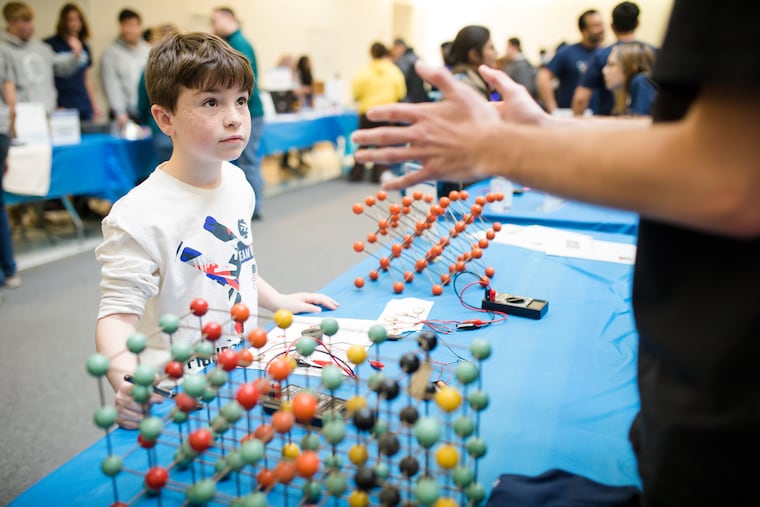‘Philly Materials Day’ returned with cool looks at how stuff is made
Drexel University’s department of Material Sciences and Engineering hosted Philly Materials Science and Engineering Day for the first time since February 2020 with demonstrations for all ages.

Jake Vandermeulen, 10, was amazed at how he was able to walk so effortlessly across the fluid’s surface.
This particular fluid, contained in about a 4-foot-long basin, didn’t act quite like most others, he explained: It was “non-Newtonian.”
If you pounded and punched at it, it would not give and would stay dense and hard. And if you walked across it quickly, you could step on it as if it were cement. But if you stayed still and planted your feet, slowly you’d start to sink in, as if you were standing in quicksand.
As Jake put his sneakers back on, he joked about how cool the fluid was.
“I wish I could bathe in this!” he said.
On Saturday, Drexel University’s department of Material Sciences and Engineering hosted Philly Materials Science and Engineering Day — or Philly Materials Day — for the first time since February 2020. The event was four hours of hands-on demonstrations for people of all ages to learn about material sciences and engineering.
» READ MORE: An ancient art form got a new twist from this Drexel engineering student, 7,000 miles from his home in China
Dozens of people filled the lobby of the Bonne Research Center as students and volunteers from Drexel, the University of Pennsylvania, North Penn High School, and other groups walked them through various demonstrations. Kids learned how to make their own polymer bouncy balls and the science behind how brakes on bicycles work and how artificial snow is made.
The event, which had been on hiatus due to the COVID-19 pandemic, was a fun way to teach people how items used daily are made and work, and to spark interest in younger students to join the field, said Steven May, the head of Drexel’s Materials Science and Engineering department and a professor at the university.
» READ MORE: At Drexel, clay-like substance could be battery of future
“The goal of this event is to sort of get the word out about the important role that materials play in our everyday lives and in a wide range of technologies that we use to benefit society,” said May.
Late Saturday morning, families packed the Mitchell Auditorium as Drexel students showed them how liquid nitrogen worked and what it does to the physical environment. With a boiling point of -320.4 degrees Fahrenheit, liquid nitrogen would freeze most materials instantaneously.
So as not to ignore the real importance of this particular weekend, one student wearing an Eagles sweatshirt prefaced the presentation with an important message.
“Go Eagles!” he said, as he threw on a slide with a picture of Eagles players, who will vie against the Kansas City Chiefs in Sunday’s Super Bowl in Glendale, Ariz. The photo was emblazoned with the Eagles’ slogan “It’s a Philly thing” and was met by cheers and laughter from the excited audience.
As the demonstration began, two students poured liquid nitrogen out of a Dewar flask onto a fully inflated balloon, and the audience gasped as the balloon immediately shrank. When students asked the audience who wanted to smash frozen rubber bands, more than 20 kids rushed the stage to try it out.
The demonstration came complete with a parting gift: ice cream made by using liquid nitrogen.
At a table where Pranjal Nautiyal was demonstrating how friction works, Maurizio Rodriguez, 11, spun the wheel on a bicycle, as it glided in a circle unhindered. But then, as Nautiyal squeezed the brake levers on the bike’s handlebar, Maurizio struggled to budge the wheel.
It was Maurizio’s first time at the event, and he thought it was all “very fascinating.” He was already interested in STEM and enjoys learning about electronics and robotics and was already coding in Javascript.
He wanted to keep his options open, hoping maybe he could end up at the Massachusetts Institute of Technology. But after walking through demonstrations on superconductivity and watching magnets make metals levitate, he thought he might like to end up at Drexel, too.
At a table demonstrating how artificial snow is made, Roman Wilson, 9, watched as water mixed with other chemicals and suddenly, a white powdery substance began to rise quickly from the beaker. His jaw dropped as he saw the substance bubble and spill over.
It was his favorite demonstration of the day, he said. It was his first time at the event, and his father had driven him all the way from Newark, Del.
» READ MORE: How a 65-ton dinosaur took a power walk
Roman roamed from table to table, listening intently to each person teaching him about a new piece of the science behind the physical world. For some time, he said, he has been conducting experiments of his own, including making his own slime using glue, food coloring, and an activator.
Experimenting, for Roman, is the best way to figure out how things work.
“I just want to see what happens,” he said.